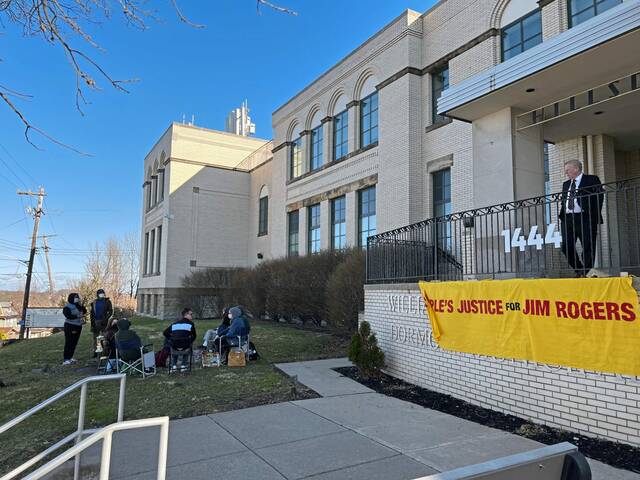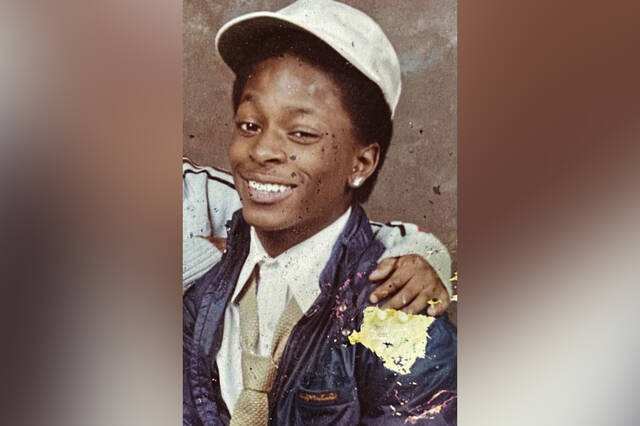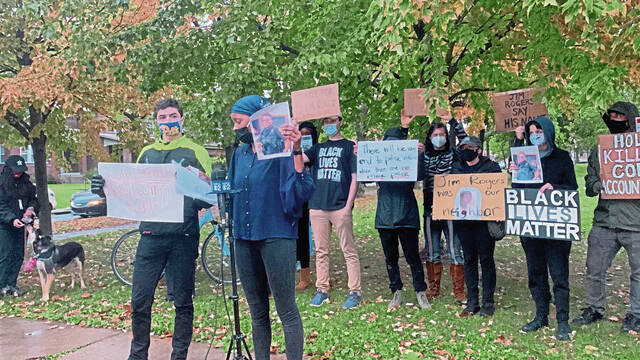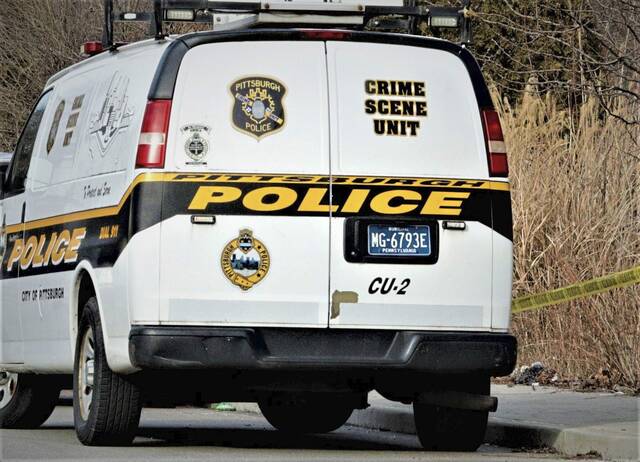The grand jury investigating the death of a homeless man a day after he was tased at least eight times by a Pittsburgh police officer has concluded its term.
The panel, which met at the Dormont municipal building every other Thursday beginning in April 2021, had its last meeting Thursday, according to Allegheny County District Attorney Stephen A. Zappala Jr.
He said the panel will not be extended.
Zappala said he could not say whether the grand jury issued a presentment recommending charges against any of the 13 police officers who were on the scene when Jim Rogers was tased on Oct. 13 in Bloomfield.
While Zappala said he could not “talk with any specificity on issues with the grand jury,” he added, “People (on the grand jury) were not happy with the conduct they saw.”
“Prior to going to the grand jury, I saw several crimes in my mind. That’s as far as I can go,” Zappala said.
Zappala said the Rogers investigation is not closed.
“There are other agencies that have an interest in the case,” he said, declining to identify which agencies.
Typically, the county grand jury is extended an additional six months when its investigations aren’t complete.
Legal experts said that if the grand jury was not extended, it could be an indication that it has concluded its investigation.
“What you can infer is there does not appear to be any further need for grand jury tools” such as subpoena power and sworn testimony, said Bruce Antkowiak, a former prosecutor who now teaches law at Saint Vincent College.
“By not seeking to extend it, there does not appear to be a need for further investigation of this matter,” Antkowiak said.
But, he added, that does not necessarily provide any insight into what conclusions the grand jury reached.
The grand jury process
In the grand jury process, the panel conducts an investigation — led by the DA’s office — in which they can subpoena witnesses, hear sworn testimony and review documents and other evidence.
Once that work is concluded, the DA’s office writes a presentment based on the evidence and charges they think are appropriate. That is reviewed by the supervising grand jury judge. If the judge signs off on it, the presentment is given to the grand jury to vote on.
If they recommend charges, the presentment is returned to the judge for verification and then given back to the DA’s office, often under seal.
The DA — Zappala in this case — can then decide whether to file charges based on the presentment, ignore the recommendations entirely or file different charges.
“This does not take away the discretion of the prosecutor that is inherent,” Antkowiak said. “At the end of the day, the prosecutor has to make the decision.”
David A. Harris, a law professor at the University of Pittsburgh, agreed that Zappala is in control.
“The DA’s office has its hands on the wheel here,” he said.
Neither Zappala, Pittsburgh police or Mayor Ed Gainey, who took office after the incident, have talked publicly about the details of what happened at the scene the morning Rogers was tased — even after announcing discipline against officers at a news conference.
A spokeswoman for Gainey said that they are prohibited from commenting on the issue in any way as the disciplinary process for the officers involved plays out.
‘I can’t breathe. Get a medic, help me’
An executive summary of the Pittsburgh Police Critical Incident Review Board obtained by the Tribune-Review provided detailed information about the Oct. 13 incident.
Pittsburgh police received a call that morning reporting that someone had taken a bike from a front yard on Harriet Street.
Officer Keith Edmonds, who is Black, was dispatched to the scene with a description of a possible suspect. According to the report, Edmonds saw a man matching the description and approached him.
The report said that Rogers was immediately compliant and raised his hands in the air. Edmonds asked him several questions, did a pat-down search and said over his police radio that no additional backup was needed.
However, the report said that when Edmonds took Rogers’ wallet from his pants pocket, a struggle ensued. Edmonds tried to control Rogers with an arm bar and gave him an order to put his hands behind his back, the report said.
Instead of trying to handcuff Rogers, Edmonds pulled out his taser. He then delivered two, one-second drive stuns — placing the taser directly against Rogers’ back — 18 seconds apart, the report said.
Edmonds then deployed his taser probes, again hitting Rogers in the back three times within 46 seconds, it continued.
Edmonds continued to tase Rogers at least eight times over a period of three minutes and 15 seconds, the report said.
Two additional officers, Gregory Boss and Patrick Desaro, arrived on scene and handcuffed Rogers. He was put in a police vehicle, where another officer, Neyib Velazquez, was in contact with him for about 17 minutes.
During that time, according to body camera footage cited in the internal report, Rogers kept hitting his head off the seat and said on at least 13 different occasions, “‘I need a hospital. I can’t breathe. Get a medic, help me.’”
Pittsburgh EMS workers came to the scene to decontaminate officers who got Rogers’ blood on them, but Rogers was never checked, the report said.
Later, when Boss and Desaro took Rogers to UPMC Mercy, Rogers became unresponsive. He was slumped over when police arrived at the hospital.
He died the next day.
In the days and weeks after the incident, Rogers’ family and community activists demanded an investigation and asked that charges be filed against the officers.
By February, it was clear that the DA’s office was using the grand jury to investigate Rogers’ death, as officers who were at the scene that day had begun to receive subpoenas to appear in Dormont.
Their testimony started later that month.
Then, in March, Mayor Ed Gainey announced that five of those officers had been fired. He refused to identify them.
Public owed ‘thorough explanation’
Although Rogers’ supporters continue to question what, if anything, will come of the grand jury investigation, Antkowiak said that there is no legal obligation on the part of a prosecutor to announce the findings.
But, Harris said, that doesn’t mean it shouldn’t happen anyway.
“The public is owed a thorough explanation whether they decide to go forward with charges or not,” he said. “What we should not accept is any situation where the grand jury doesn’t bring charges, and the district attorney says (the panel) made the decision.
“That should raise flags that the grand jury is being used for cover for a decision by the DA not to bring charges.”
There are legitimate reasons to withhold a presentment or delay filing charges, including if there is a related, ongoing investigation happening outside of the grand jury or if the panel is working on a report with recommendations to community stakeholders.
The investigating grand jury has traditionally been used to investigate corruption, white-collar crime, politicians and public officials.
In some instances, if there isn’t evidence of a crime but there is evidence of wrongdoing, the grand jury will issue a report in which they lay out what problems they found and what recommendations they have for addressing them.
That has happened several times in recent years with Allegheny County’s investigating grand jury, including during investigations into sexual assaults at Western Psychiatric Institute and Clinic, teacher sexual abuse at Plum Borough School District and a 2018 report critical of how the Pittsburgh Police handled officer-involved shootings.
The reports are done to provide a kind of roadmap for the community to make change.
“It may have the effect of prodding other government entities into action,” Harris said.
‘Substantial issues with training’
Several of the defense attorneys representing the police officers involved in the Rogers case said Thursday that they have heard nothing from prosecutors.
Lee Rothman, who represents Desaro, said the grand jury process is private.
“The District Attorneys’ office is in control of that, and I have no knowledge of what they’re doing or how they’re doing it,” he said. “It’s designed for us not to know.”
Steve Townsend, who represents Glen Bogart, a K-9 officer who responded to the scene that day, said he thinks there needs to be some announcement.
“I absolutely think when you convene a grand jury to investigate any crime, at some point in time, you have to let the public and the potential accused know if there will be no charges filed,” he said. “I don’t think it’s appropriate to have it hanging over their heads until the statute of limitations runs out. It’s just not right.”
Patrick Thomassey, who represents Sgt. Carol Ehlinger — one of the supervisors on the scene that day — agreed.
“I would hope if the grand jury decides not to charge anybody, the DA would have a press conference and say that,” he said. “These officers have been under investigation, and if they’ve been cleared, he should go on the record and say that.”
Zappala said he intends to talk about the Rogers’ case — and the policy implications regarding how the taser was deployed that day and how the 13 officers on the scene responded to Rogers.
“There are substantial issues of training, trainers and curriculum,” he said. “I wanted the public to hear that. I’m going to talk about it.”
Zappala said he was ready to talk about that issue a long time ago, but knew the city administration was changing.
“I think this is a really important issue — not withstanding that somebody died,” he said. “How do we treat people when we walk up on them as a police officer? I was dissatisfied by the explanations I was hearing from the city.”
Homicide charges unlikely, expert says
If criminal charges do result from the grand jury, how a defendant is processed depends on the severity of the counts filed against them. If the charges are felonies, the subject would likely be arrested. If they are misdemeanors, they could be mailed to the subject.
In the Rogers case, Antkowiak said he suspected that if charges are filed, they will likely be lesser counts such as recklessly endangering another person.
He said it would be difficult for the DA’s office to pursue a homicide count — even involuntary manslaughter — given the circumstances of Rogers’ death.
“You have to be able to prove the defendant caused the death,” he said.
That became more difficult in the Rogers’ case when the Allegheny County Medical Examiner’s office ruled in January that the manner of death was accidental.
The cause of death, the ME’s office said, was a lack of oxygen to the brain.
“It’s going to make it very hard for a prosecutor to convince a jury that that is a medical determination, and this is something else,” Antkowiak said. “I suppose you could do it, but it’s going to be a very difficult thing.”
He said that the pathologist’s testimony at trial is essential to talk about the extent of a victim’s injuries and the potential state of mind of the perpetrator.
“When you don’t have that, it really undercuts, at a fundamental level, the ability to look at a homicide charge,” he said.
Court of public opinion
Harris said that anything less than a homicide charge will likely be received poorly by the community.
“I don’t think it will be received well even if it is the right legal decision,” he said.
The best way to combat that, Harris said, would be by offering a “thorough, public explanation.”
“You basically have to be as open and transparent as the law will allow. Otherwise, you’re losing public trust by failing to look after it,” he said.
Ultimately, prosecutors are held accountable for their actions by the electorate, Antkowiak said.
“If the public is dissatisfied with how the prosecutor is doing, there’s a way to handle that, and that’s by voting in the next election,” he said.
Zappala, whose term ends in 2023, has not announced whether he plans to run again. He said Thursday it’s too early for that.
He won his last primary and then faced now-Common Pleas Judge Lisa Middleman as an independent challenger in the 2019 general election and won by a 14-point margin.













